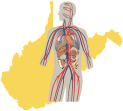The Burden of Cardiovascular Disease in West Virginia
Credits
Summary
Chapter 1
Chapter 2
Chapter 3
Chapter 4
Chapter 5
Chapter 6
References
Appendix A
Appendix B
Appendix C
Appendix D
 Executive Summary
Executive Summary
Since 1940, cardiovascular disease (CVD) has been the number one killer in both the United States and West Virginia. Heart disease and stroke, the two main categories of CVD, accounted for 39.5% of all deaths in West Virginia in 1999. Although some groups are disproportionately affected by CVD, it is the leading cause of death for both men and women and among all races and ethnicities, all income and educational levels.
Certain risk factors enhance a person's chances of developing CVD. Nonmodifiable risk factors include age, gender, race, and heredity. Modifiable risk factors are those that are amenable to intervention such as tobacco use, physical inactivity, hypertension, high cholesterol levels, obesity, and periodontal disease. Diabetes is an independent risk factor for CVD; it increases the risk of heart disease by two to three times and that of stroke from two to six times.
When compared to the rest of the country, West Virginians have higher prevalences of all the CVD risk factors listed above. Both adults and youth in the state report smoking at higher rates than their counterparts elsewhere; state adults reported significantly higher rates of hypertension in 1999 than others nationwide. The state's prevalence of tooth loss among adults was the highest in the nation in 1997. Forty-four percent (43.7%) of adult West Virginians reported being physically inactive in 1998, compared with an average of 27.7% in the U.S. as a whole. Obesity has long been a problem among both adults and youth in West Virginia. In 1999, state adults were 25% more likely to be obese than their peers nationwide, youth were 23% more likely. Adults were 24% more likely to report high cholesterol levels. In that same year, the prevalence of diabetes among state adults was 7.3%, the fourth highest among all the states.
The Health Care Financing Administration estimated that in 1995 personal health care expenditures attributable to cardiovascular disease in West Virginia totaled $683 million. This represented 12.7% of all personal health care expenditures in the state in that year.
In 1998, there were a total of 229,226 inpatient hospital discharges of West Virginia residents from West Virginia hospitals. According to data provided by the West Virginia Health Care Authority, heart disease was the primary diagnosis on 15.3% of all discharges; stroke was the primary diagnosis on 3.4% of discharges. Both men and women in West Virginia had higher rates of heart disease and stroke hospitalizations than their national counterparts. Over one-fourth of all charges billed by West Virginia hospitals in 1998 were for hospitalizations having CVD as the primary diagnosis. Approximately $470 million was billed in that year for either heart disease or stroke hospitalizations. Sixty-nine percent (68.8%) of CVD-related charges were billed to Medicare, with 10.0% billed to private insurers and 7.4% to Medicaid.
West Virginia's age-adjusted rate of heart disease mortality was 328.9 deaths per 100,000 population in 1998, 21% higher than the U.S. age-adjusted rate of 272.4 and the second highest among all 50 states and the District of Columbia. The state's 1998 age-adjusted rate of stroke mortality was 60.3, slightly higher than the U.S. rate of 59.6. A 1999 Bureau for Public Health study using data from 1986 through 1995 reported that African American residents had higher rates of death from both heart disease (396.6 vs. 343.9) and stroke (75.5 vs. 59.2) than did white residents.
Access to quality care is an important factor in the fight against cardiovascular disease. In 1999, 18.1% of West Virginia's adult population lacked health care coverage; the U.S. median was 12.4%. Fifteen percent (15.4%) of state adults reported not being able to afford health care, compared with 9.6% of adults nationwide. Health care provider shortages exist in many areas of the state. In 2001, there were 50 federally designated Health Provider Shortage Areas in the state comprising all or part of West Virginia's 55 counties. In addition, 50 counties were wholly or partly designated as Medically Underserved Areas.
The burden of cardiovascular disease in West Virginia is being addressed in part by the West Virginia Cardiovascular Health Program located within the Bureau for Public Health. The program, which is funded by the U.S. Centers for Disease Control and Prevention, is guided by the vision of "creating a culture of cardiovascular health in West Virginia." The mission of the Cardiovascular Health Program is to establish environments and policies that promote heart health in West Virginia.